Porcelain Insulator News
by Elton Gish
Reprinted from "Crown Jewels of the Wire", September 1992, page 5
When Jack Tod asked me to take over writing Porcelain Insulator News in 1984,
it seemed that my greatest concern was, "What will I write about?",
due to the shortage of new reports, and my general lack of knowledge on the
subject. Now, eight years later, it seems that my greatest concern is "What
will I write about?", but now I have so much information to choose from,
that was sent in by "you". Don't get me wrong, I am not asking
everyone to stop writing with news of their unusual finds, but rather I am
apologizing for not running many of your interesting finds in a timely manner.
Multipart collecting has mushroomed to the point that uniparts, go-withs, and
other odd types have gotten short-changed in the available PIN space to report
them. Some of you may have noticed that PIN is now about 2- 3 times as long as
it was eight years ago, but still we are getting behind. So, please forgive me
if your news item does not make it to PIN in a reasonable time period.
In
August, 1991, we described two unusual "salesmen's give-aways". Most
of these types of items are ashtrays, and this month we will show you four
different ones. An ashtray made a nice advertising gift during the
1920's-1950's. Since most men smoked during that time, an ashtray was a
practical gift, and it usually found daily service. They were kept on the
customer's desk, where he could be reminded every day of the generosity of the
manufacturer or salesman. Today, it seems that calendars and coffee cups fill that need.
Ashtrays were usually marked with the company name, and many had miniature
insulators fixed to them. The white ashtray shown below is one such example. The
embossed marking "THOMAS QUALITY" is shown twice around the upper flat
surface of the rim, and again on opposite sides of the insulator. This is a very
attractive go-with for a porcelain collector. This ashtray probably dates back
to the late 1920's. There are at least a half dozen or more of these in
collections.
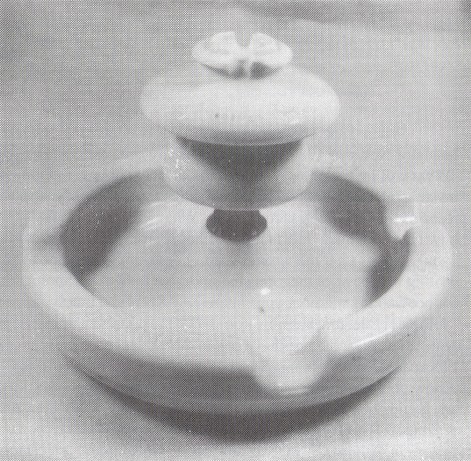
The next two ashtrays were not made to be typical salesmen's give-aways, but
rather to commemorate a special onetime event. This fact contributes to their
rarity.
The ashtray pictured (below) was found by Bob Stahr at the local Salvation
Army store in Chicago. Needless to say, Bob did not give big bucks for this one.
The ashtray is chocolate brown with two rings on the side like a post-type
insulator. In the center, there is an image of a suspension insulator string,
with attachment equipment to support two conductor cables. Along with the
markings "LAPP" and "EHV TEST" (extra high voltage) is the
signature of "William Shafer". This Lapp ashtray is surely
one-of-a-kind.
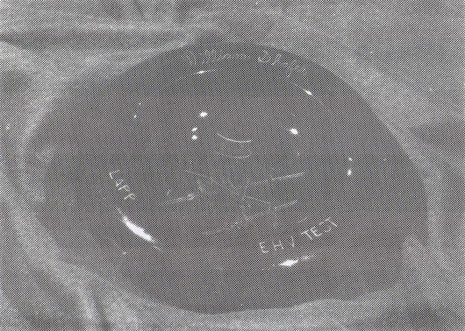
The next ashtray (pictured on the following page) is very unusual and
attractive, with cutouts in the sides. It has a very pretty, shiny mahogany
glaze. The marking on the side-reads:
The Fred M. Locke
CERAMIC RESEARCH LABORATORY
Dedicated
Sept. 30, 1947 at
Baltimore, Md.
There must have been several of these given out to the dignitaries present
for the dedication, but this particular one was presented to James L. Locke, the
fourth son of Fred M. Locke.
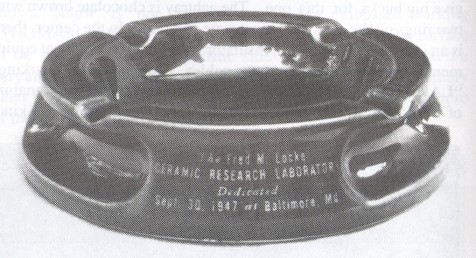
The ashtray (below) is the only one in existence! It is not known why the
ashtray was made. Only four were made in 1953 at the Victor Insulators factory
in Victor, N.Y. All four ashtrays were made by Harry Dunham, an employee at the insulator plant. The owner of the
ashtray told me that he knew Mr. Dunham well, and that three of the four
ashtrays had met an untimely fate, and were thrown away. The glaze is a very
pretty, light tan with blonde edges. It measures 8-1/2" square and is 1-3/4" tall.
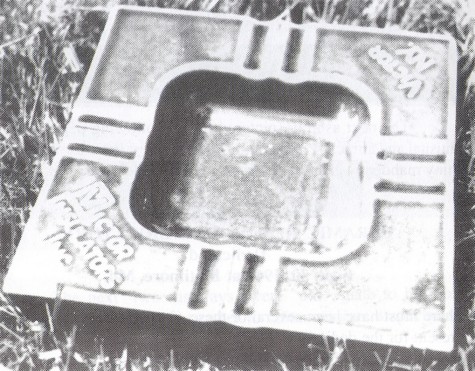
If any of you have an insulator related ashtray or salesman's
give-away, please send me a photograph and description. As we collect the
photos, I will try to run them in PIN. Then, if there is enough collector
interest, and if we get enough good photographs, I would like to publish a small
booklet showing all of the ones that you have shared. To take a picture of your
item that is suitable for publishing, you will need a 35mm camera that will take
a fairly close picture, to show detail and keep it in focus. Use a neutral
background, such as a sheet or tablecloth, with outside natural lighting.
In the
January, 1992 issue of CJ, we reported a new Etheridge patent style, U-376C, which
was found by Bill Rosato and Claude Wambold in an old steel mill in McKeesport,
PA. David Adams sent in that report. Now, Bill Sutliff reports finding several
insulators in another old steel mill in Pennsylvania that are similar to the
U-376C Etheridge cable-top design; however, these specimens are of a different
design and manufacturer. This new design has been assigned, U-376D. The U-376C
specimens are all unmarked, but we are reasonably sure that they were made by
Thomas. The glaze color on my U-376C specimen (mottled orange-tan) exactly
matches the specimens that I have of U-376A and U-376B. All three styles were
cataloged by Thomas in 1907.
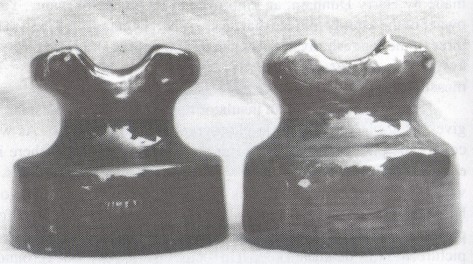
U-376D VICTOR (left) and U-376C (right)
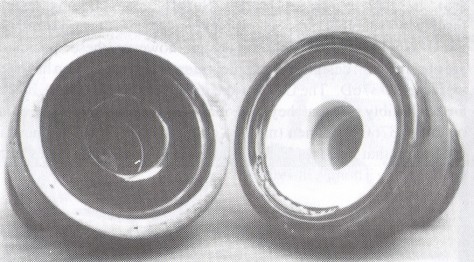
U-376D VICTOR (left) and U-376C (right)
The U-376D's that Bill found have the incuse marking, VICTOR, on the side of
the skirt. The glaze colors are dark mahogany to almost black. Most of Bill's
specimens also have, S409, scratched on the bottom edge of the insulator, which
is the firing rest (see photo on following page). The pinhole design is exactly
like that of U-376C, however, the outside shape is somewhat different. This is to be expected from
another manufacturer. It is not unusual for companies to use more than one
supplier to keep from being dependent on one manufacturer, and to increase
competitive pricing.
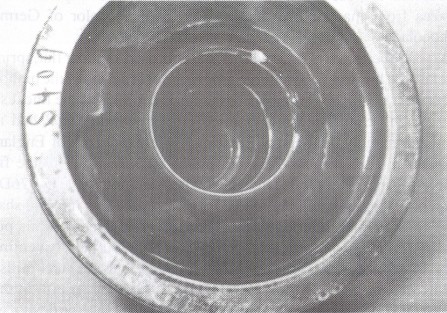
U-376D with "S409" marking
Bill did recover several of the very rusty cast iron pins. Unfortunately, the
spring-metal clips. which fit in the pinhole groove to secure the insulator,
rusted and fell out many years ago. The pin does have a slot cut out down from
the top on either side of the pin, where the clip would have protruded out into
the pinhole groove. The insulator rested on top of the split tubular pin. but
none of the insulators were damaged at the top of the pinhole, since they did
not move around much in that service.
The 1902 C. S. Knowles catalog has, by
far, the best illustration that I have ever seen of the standard Etheridge
patent insulator. It clearly shows how the flat, spring-metal clip was used to
secure both the insulator on the pin. and the pin in the crossarm. This full
page illustration is shown below. I hope that you will note with interest. that the implied manufacturer was Imperial Porcelain Works.
Their familiar crown
logo is shown, but they apparently quit using it on their insulators sometime
around 1901. Catalog No. 1090 is U-376B and No. 1091 is U-376A. To date, no
Etheridge patent specimens can be attributed to Imperial. The known specimens
ofU-376A and U-376B have glazes that are very non-typical of Imperial. Such
glaze colors are similar to those used by Thomas, circa 1902-1905. Imperial brown
glazes from that era are thick, shiny, and the color of German Chocolate.
Albeit
hat U-376Cand U-376D both used a similar flat, spring-metal clip; however, the
pinhole groove is not at the top of the pinhole, but rather near the bottom
where the insulator body is the thickest.
Bill Sutliff recently pointed out
something that I had not noticed; namely, that Harry Etheridge, while a citizen
of England, resided in McKeesport, Pennsylvania -- the town where the first
cable-top units were found, and near where Bill found the U-376D's. The only
known specimen of U-376B was found in a railroad shack in Pennsylvania.
Etheridge was an electrical engineer and his published comments and articles
appear in the AlEE Journals. It is entirely possible that he may have been
employed by one of the steel mills in McKeesport, and that they found his invention
very useful in their large mill construction projects. However, I doubt that the
design was initially intended for heavy cable service, since the patent stated
uses for the new design as follows:
"...[for] commercial telegraph, telephone, electric light, and power lines,
wherein great strength is required, particularly at curves and grades or dips;
and the object of my invention is to provide a form of insulator and pin that
will not only be self-locking, strong, durable, and quickly applied, but will
also permit the insulator to freely rotate on the pin, so as to yield to the
great strain placed thereon at all angles and positions of the line-wire."
Another interesting point about the patent is that it was filed on May 9,1901
and granted with phenomenal speed on June 25, 1901.
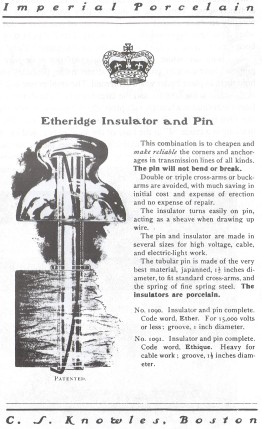
Medium Image (112 Kb)
Large Image (250 Kb)
From the 1902 C.S. Knowles catalog ...
John Webster sent photographs and descriptions of two odd white porcelain
items. They do not appear to be "insulators" in the common sense. They
look to me like they were used as caps to possibly cover an unused terminal. Do
any of you have a clue as to what these seemingly old objects were used for?
Could they have been special items used in a power plant or substation? Help! !
Both are white glazed porcelain without a tie-wire. The pinholes have circular
grooves around the inside, probably used to hold them in place better when
cemented. The smaller one is 2- 3/16" in diameter at the bottom, and the
larger one is 3". Both measure 2" from the bottom to where the side
protrudes out to make the mushroom top. One is 3-7/16" tall and the other
one is 3-13/16" tall. The only marking is a crude "4" at the base
of the smaller one, and an "8" on the larger one. If you know anything
about these, please contact me. John is anxiously awaiting an identification of
this odd "what-is-it".
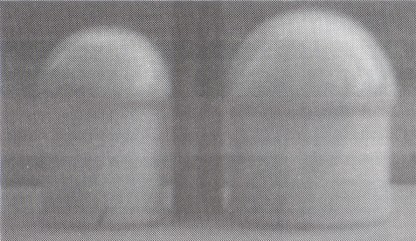
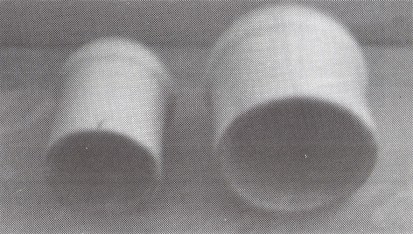
|
